Draft horses are famous for their strength, endurance, and easygoing nature. Most of these horses originate from challenging climates where they were kept for manual labor that involved plowing, hauling loads, and other activities.
Despite being muscular and powerful, most draft horses have a docile temperament and are calm.
Over the years, different draft horse breeds have been developed. Read on as we list some of the most common draft horses and their characteristics.
Table of Contents
16 Types of Draft Horses
Here are sixteen draft horse breeds:
1. Shire
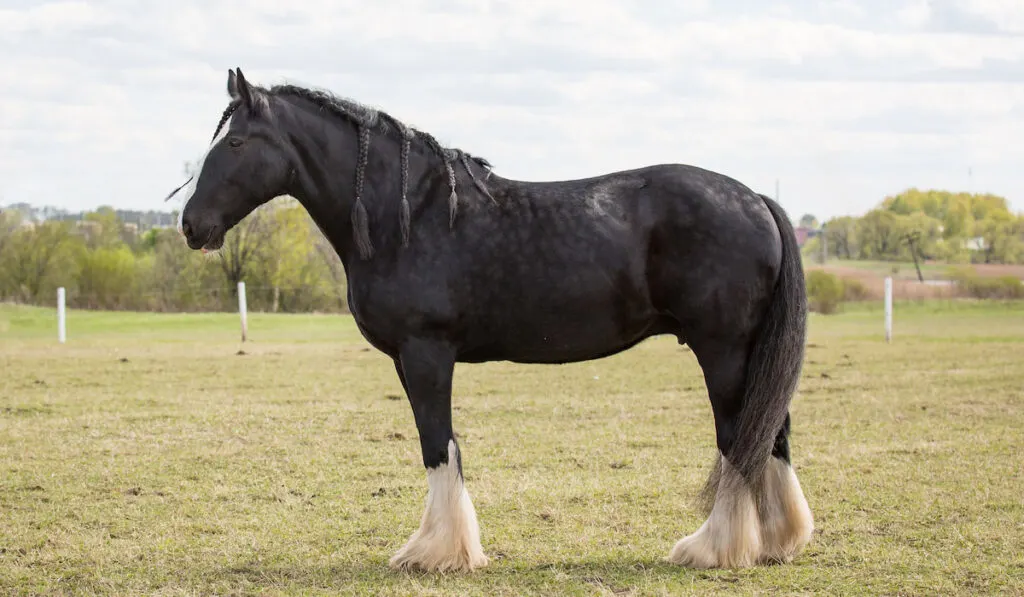
- Height: 16-18 hands
- Color: Black, bay, gray, chestnut
- Temperament: Docile and gentle
- Uses: Riding, driving, plowing
Shire horses are the largest draft horse breed.
These horses are initially from England from places like Staffordshire, Derbyshire, and Hertfordshire.
These horses were used to carry men into battle. Over time, they were used for hauling, agriculture, and as war horses.
The breed can be brown, bay, black, or gray. It’s also common to find some that are chestnut. White spots or marks are considered undesirable in Shires.
A Shire horse is about 16.2-19 hands high. They also weigh about 1,800-2,500 pounds.
Other distinct features include muscled bodies, well-arched necks, Roman noses, and feathering on their legs.
Many use Shire horses for riding. It’s also common to find Shire horses plowing.
2. Percheron
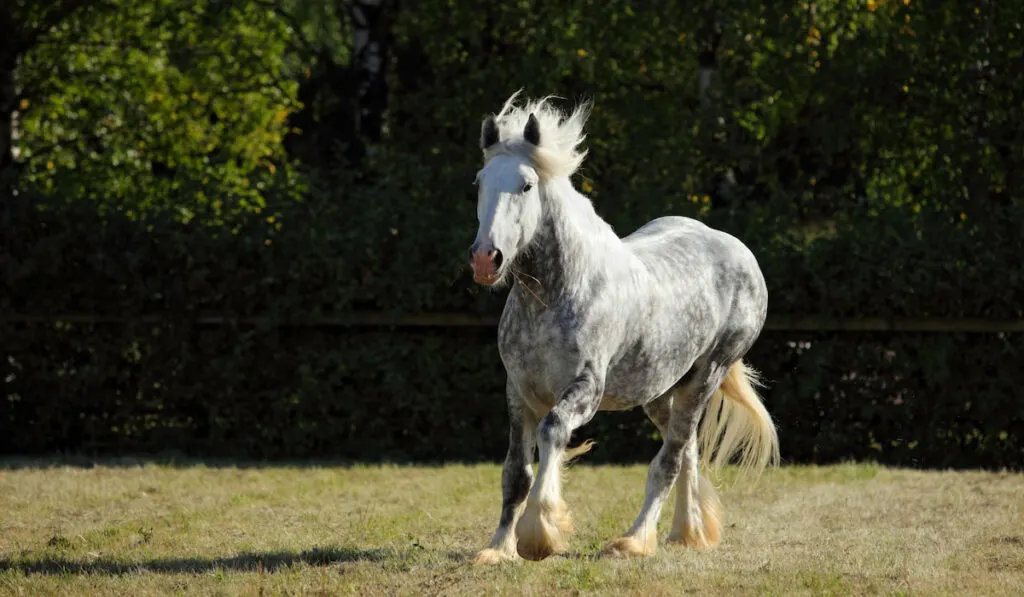
- Height: 15-19 hands
- Color: Black, gray
- Temperament: Calm, intelligent, willing to work
- Uses: Carriage driving, forestry work, competition
Percherons are one of the oldest draft horse breeds.
Originally from France in the province of Le Perche, these horses were used as war horses before being later used for agricultural work.
Their exact ancestry is unknown. These horses were probably bred from the Flemish and Barb horses and possibly Arabian horses.
This French draft horse has a broad forehead, small ears, and large eyes.
A Percheron is about 15-19 hands high and weighs about 1,600-2,300 pounds.
These draft horses are intelligent and willing to work. Their stamina and strength also make them excellent farm worker horses.
Today, people use Percherons for driving, riding, and working horses.
3. Clydesdale
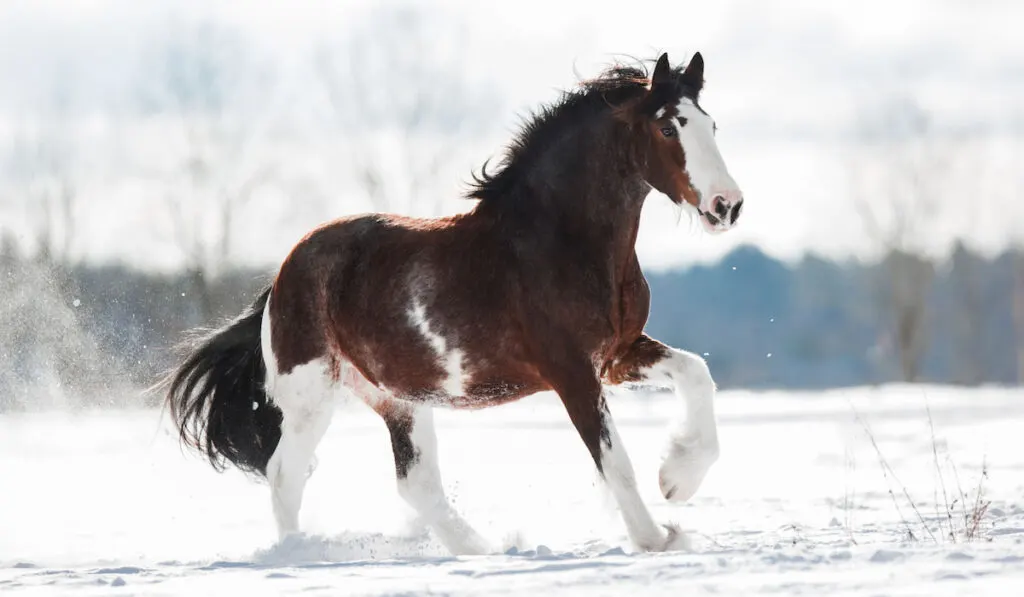
- Height: 16-18 hands
- Color: Bay, roan, black
- Temperament: Friendly, intelligent
- Uses: Parade horses
Clydesdale is another large draft horse breed easily recognizable by height and mane.
Originally from Scotland, Clydesdales were bred from Flemish and Shire horses. These horses were used for road haulage and farm work.
This draft horse stands between 16-18 hands tall and weighs about 1,800-2,200 pounds. They are also muscular, with arched necks, and have beautiful eyes.
Clydesdales are a bay color and have marked feathering around their legs.
Over the years, the breed’s appearance has changed. Modern Clydesdales are more athletic, narrower, and taller. These horses are intelligent and friendly.
Today, Clydesdales do well as carriage or parade horses.
4. Belgian Draft
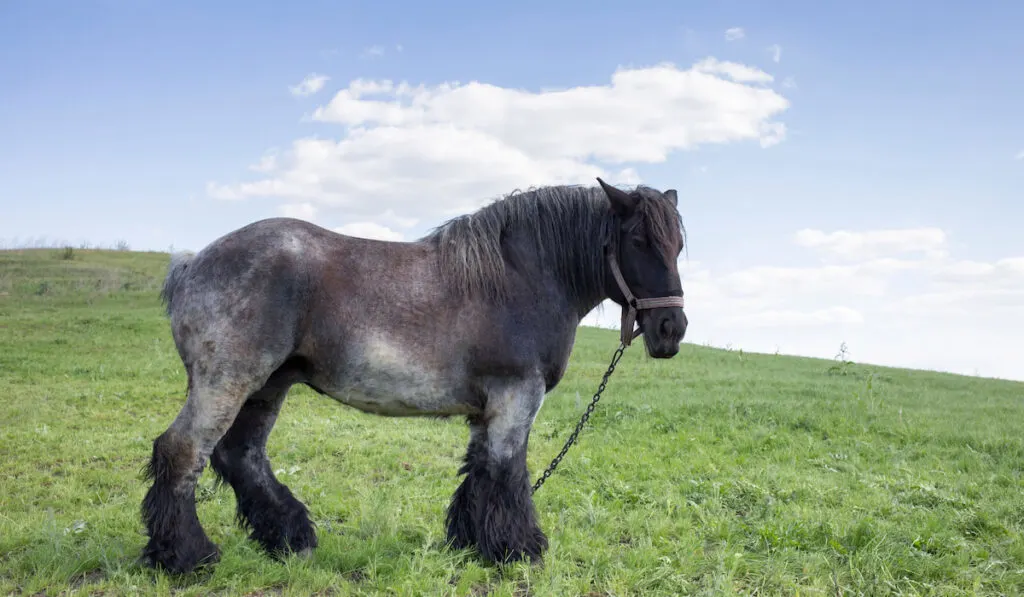
- Height: 16.5-19.5 hands
- Color: Sorrel, roan, chestnut
- Temperament: Stubborn, docile, friendly
- Uses: Hauling, showing, riding
The Belgian draft is one of the strongest draft breed horses. It’s also one of the most popular draft horses in the U.S.
Originally, the Belgian draft was bred from the Great Flemish horse in the 1800s. These horses were used for war.
The horse came from Belgium in the Brabant region.
Back in the day, the Belgian Draft and Brabant horse were the same breed before the Belgian draft became an independent breed in the 1940s.
These horses weigh 1,800-2,200 pounds and are about 16.5-19.5 hands high.
They also have muscular, strong bodies, light feathering, stylish necks, and sturdy heads.
Belgian Draft horses have a sorrel or roan coat, but some are in other colors. American Belgian Draft horses have a light chestnut color, are taller, and have lighter bodies.
Although the breed can be stubborn with strangers, Belgian draft horses become docile and friendly over time.
Belgian Draft horses are intelligent.
Modern Belgian Draft horses are versatile; you can find them driving hitches, logging, and doing farm work. They are also used for showing and riding.
5. Haflinger
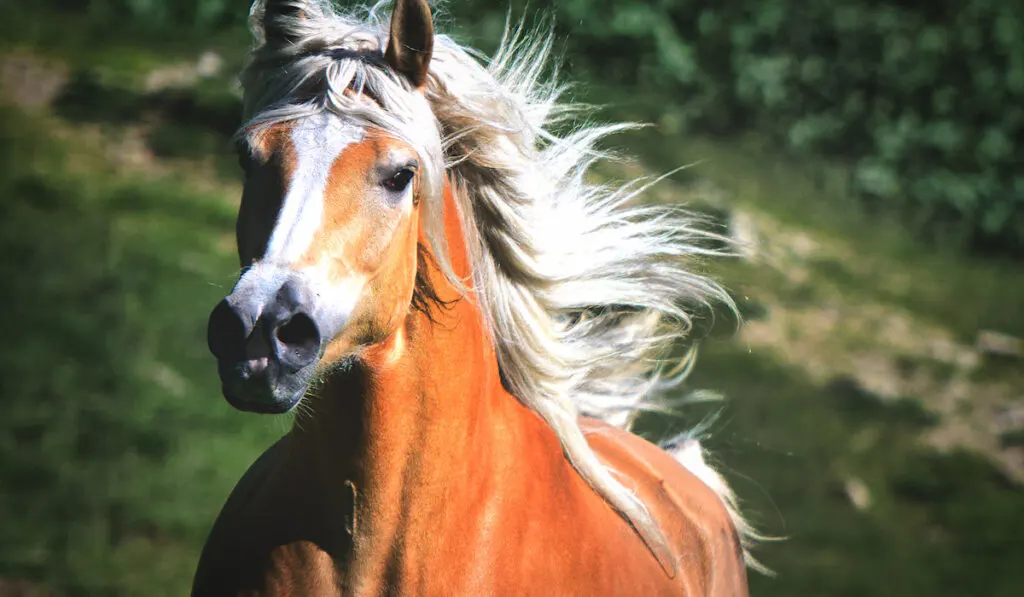
- Height: 13.5-15 hands
- Color: Chestnut
- Temperament: Kind, gentle
- Uses: Military work, riding, therapy
The Haflinger is another draft horse breed from Northern Italy and Austria. It’s also one of the smaller draft horses.
These horses were developed in the 1900s as workhorses.
There are two types of Haflingers: the lighter, tall breed and the stockier, shorter breed.
Haflingers are a chestnut color. They are muscular, and their tail and mane are flaxen.
Considered one of the versatile draft horse breeds, the Haflinger can be used for draft work and under saddle.
You can still find these horses being used for forestry work.
6. Suffolk Punch
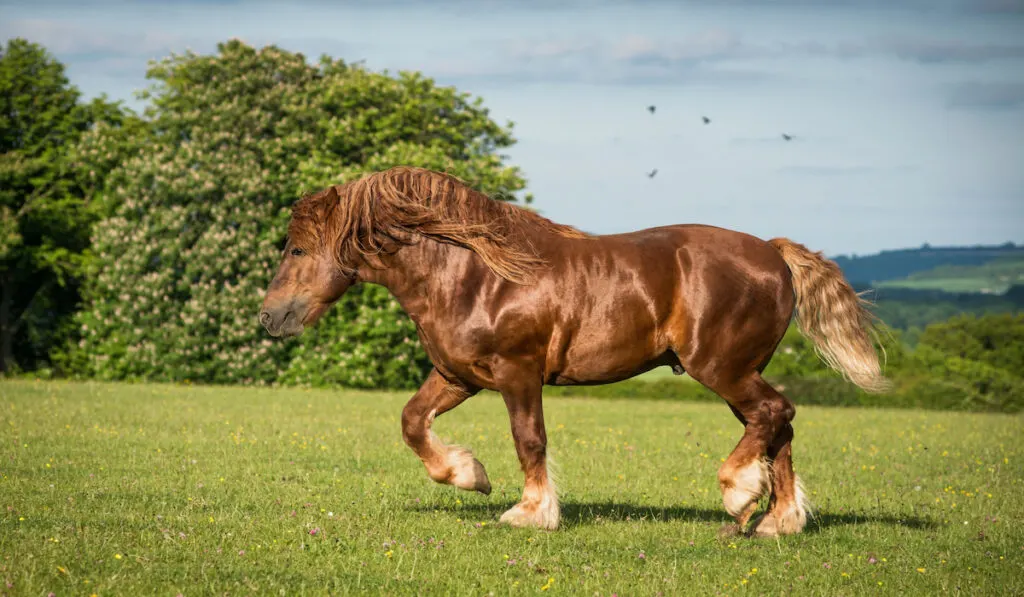
- Height: 15-17 hands
- Color: Chestnut
- Temperament: Gentle, hard-working, easygoing
- Uses: Driving, logging, showing, farming
The Suffolk Punch is another draft horse breed famous for its strength and energy. Originally from England, this horse was developed in the 20th century for farm work.
Suffolk Punches were also used to pull heavy machinery during World War II.
On average, these horses stand between 15-17 hands high and weigh about 1,600-2,000 pounds.
You can easily recognize a Suffolk Punch due to its thick arching neck; tall, masculine build; and distinct chestnut coat.
Suffolk Punches also have a muscular croup and a stocky appearance, as they’ve never been used to pull a carriage.
They are also easy to keep and willing to work, which makes them great for beginners.
People like to use the Suffolk Punch showing, driving, logging, and farming.
7. Irish Draft
- Height: 15.2-16.3 hands
- Temperament: Docile, calm, friendly
- Uses: Police horse, showing, hunting
The Irish Draft is one of the best all-rounders.
Developed in the 18th century, this Irish draft horse breed is a mixture of Spanish and English horse breeds. Back then, it was suitable under saddle, in harness, and was often used for farm work.
Irish Draft horses stand at about 15.2-16.3 hands high and weigh about 1,300-1,400 pounds.
The versatile horse is renowned for its docile temperament and easygoing nature. The horse breed has also been used to develop other sport horse breeds, leading to its decline.
The Irish draft is excellent as a police horse and for showing and hunting.
8. Ardennes
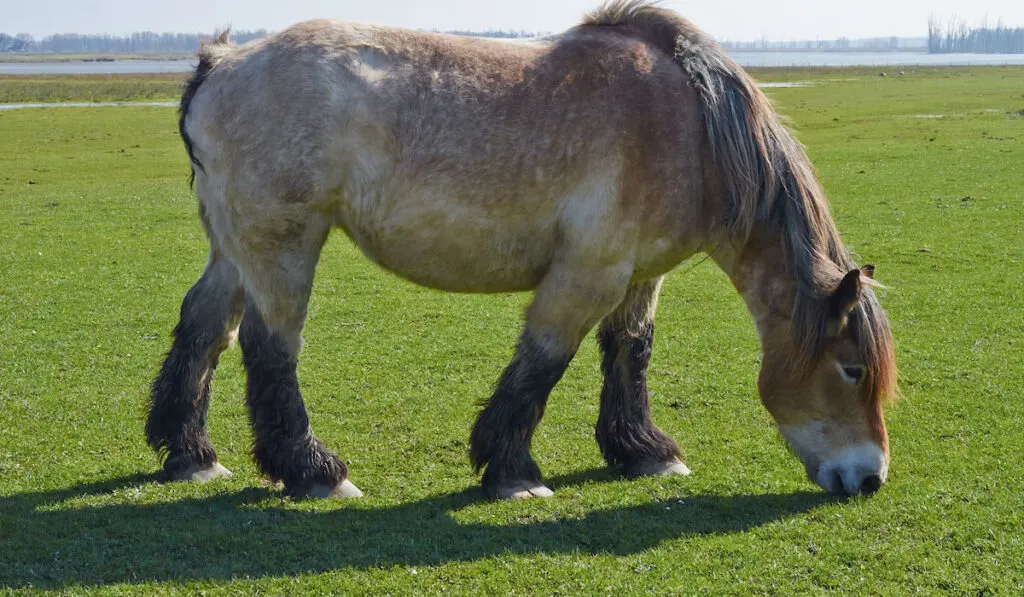
- Height: 15-16 hands
- Color: Bay, chestnut, roan
- Temperament: Kind, tolerant, affectionate
- Uses: Therapy, pleasure riding
The Ardennes horse breed is from Europe. It’s originally from a region in Belgium called Ardennes.
These horses were mainly used for draft work. However, the breed has been crossbred with other breeds to make them stronger and bigger.
Ardennes horses stand at 16 hands high and weigh close to 2,200 pounds on average. Their legs are muscular, which gives them pulling power.
If you’re looking for horses that are patient, intelligent, and easy to work with, you’ll find all these traits in the Ardennes horses.
They are also calm and docile, which makes them perfect for beginner horse owners.
An Ardennes is hardy and can adapt to any weather.
Ardennes also feed on hay and grass but may need supplements if you plan to use them for work.
Although Ardennes horses are draft horses, they are also used for competitive driving, pleasure riding, and on farms to pull equipment.
Ardennes horses also make excellent therapy horses due to their tolerant personality and kind temperament.
9. Dutch Draft
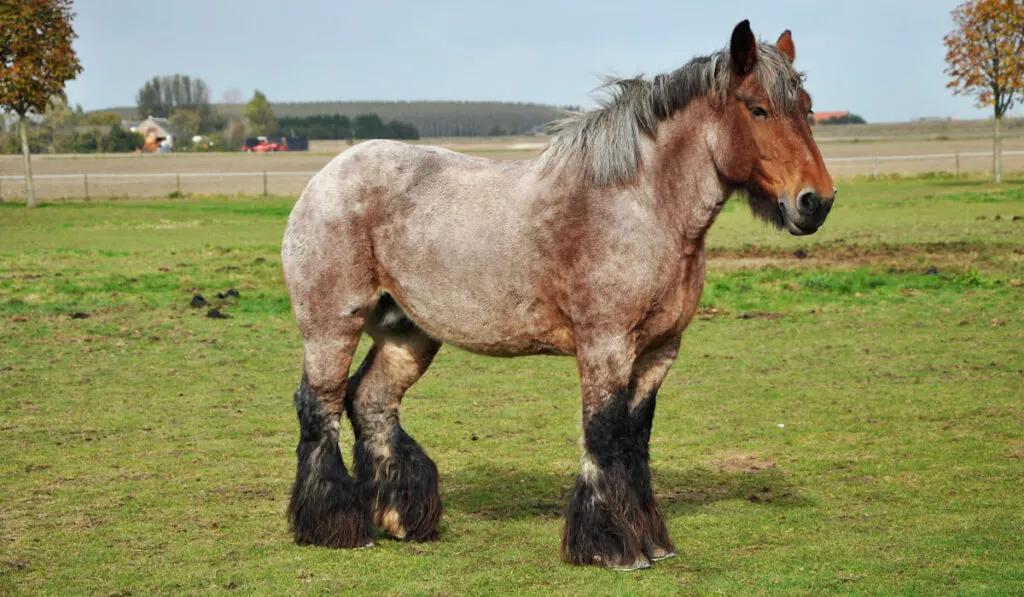
- Height: 15.2-16 hands
- Color: Chestnut, gray, black, bay
- Temperament: Calm, friendly
- Uses: Dressage, recreational riding, driving, farm work
Dutch draft horses are from the province of Zeeland in the Netherlands. The breed was developed for World War I but was later used for farm work.
This muscular horse stands about 15.2-16 hands high and weighs about 1,300 pounds or more on average.
Dutch draft horses can be black, gray, chestnut, or bay. They also have lower leg feathering and a thick mane.
Despite its intimidating appearance, the Dutch draft horse has a calm temperament.
Modern Dutch draft horses suit recreational riding, driving work, and dressage. It’s also possible to find them on farms.
10. Friesian Horse
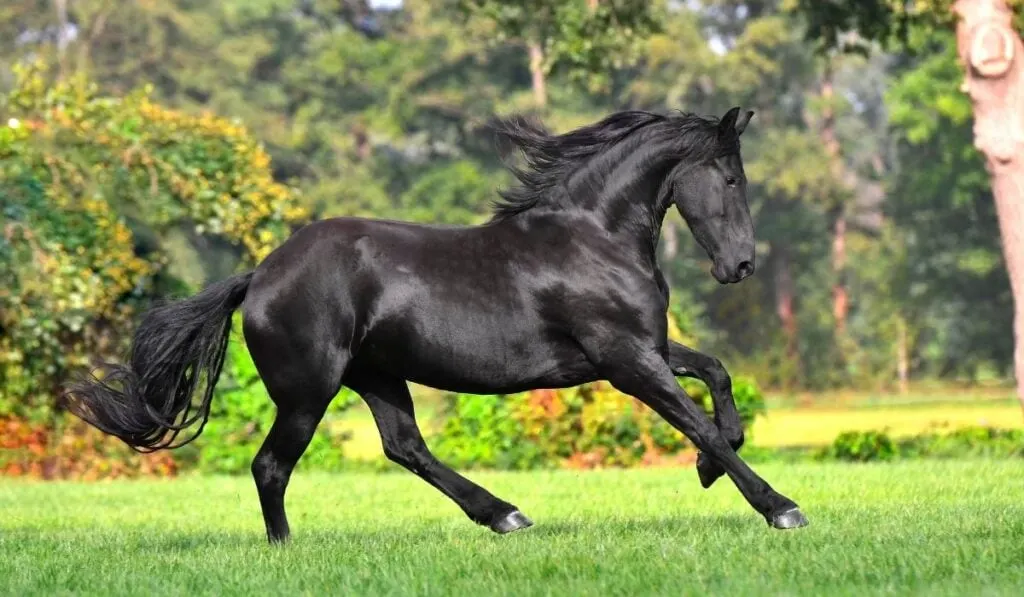
- Height: 14.5-17 hands
- Color: Black, bay
- Temperament: Quiet, calm
- Uses: Dressage, competitions, historical movies
The Friesian is a graceful, lighter draft breed. These horses come from Dutch islands called Friesland.
Friesian horses were used for agriculture and as war horses. They were also used as riding horses.
Fresian horses are black. However, the black can change to a black-bay shade when shedding in the spring. Or it can be a bay-black and turn into a true black.
These horses have thick tails and manes that can be wavy and long. These horses have feathers on their lower legs.
A mature Friesian horse stands at 14.5-17 hands and weighs about 1,200-1,400 pounds.
Friesian horses are calm and quiet.
They are solid and cheerful when around people. They are easy to work with, and some people find them eager to please.
Their gentle nature also makes them ideal for beginner horse keepers and kids.
11. Jutland Horse
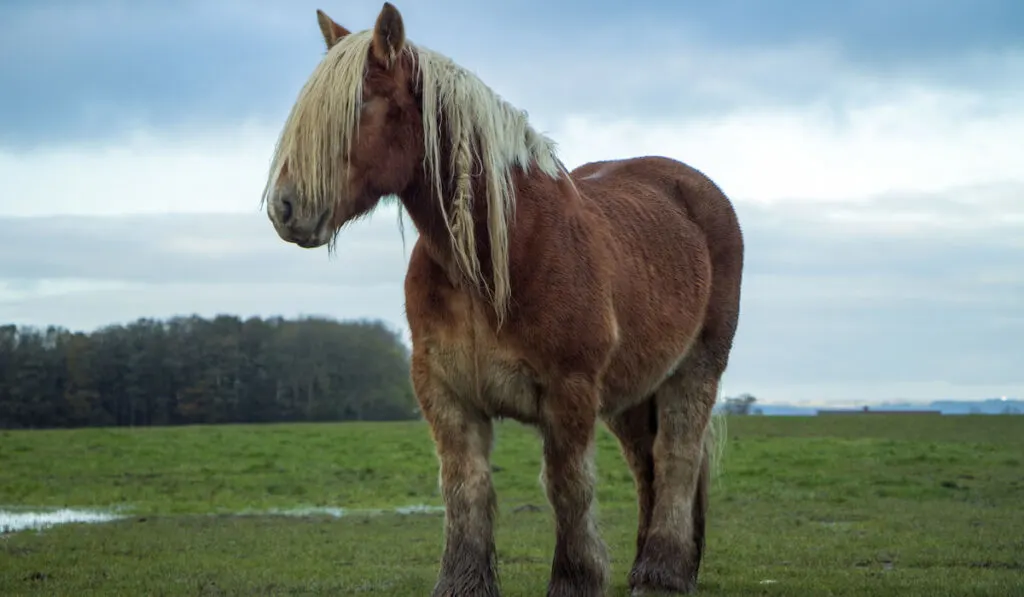
- Height: 15-16.1 hands
- Color: Black, gray, roan, chestnut
- Temperament: Gentle, calm
- Uses: Farm work
The Jutland horse breed got its name from the Jutland Peninsula in Denmark.
In ancient times, these horses were used as draft horses and for horse shows due to their muscular and compact nature.
The breed may contain the bloodlines of the Suffolk horse and the Shire horse.
Physical characteristics of the Jutland horse include its powerfully muscled shoulders, strong hindquarters, and feathering on all legs.
A Jutland is typically chestnut in color, although it can also be gray, black, and roan with white markings.
Most Jutland horses stand between 15- 16.1 hands and weigh 1,500-1,800 pounds.
Jutland horses have a gentle temperament despite their strength and size. They are kind, calm, and willing to work. That makes them ideal for hauling farm equipment and doing other farm work.
Modern Jutland horses do well performing farm work and hauling big items.
12. Fjord Horse
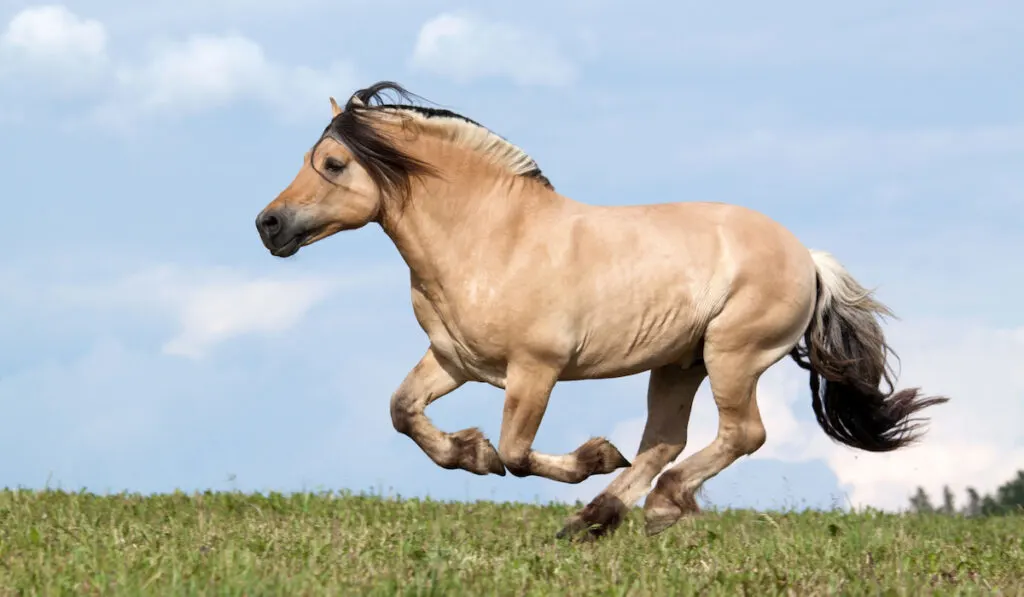
- Height: 13-14 hands
- Color: Dun, brown, black
- Temperament: Willing to work, docile
- Uses: Competition, dressage riders, drivers
The Fjord horse is from Norway and was used for heavy lifting in ancient times.
These draft horses have muscular physiques and dun coats. Being light draft horses, Fjords stand only 13-14 hands high.
This draft hose has horizontal stripes on the back of its front legs, and its mane can have brown and black.
The Fjord horse’s friendly, calm temperament makes it excellent for beginning and young riders.
They are also trainable and easy to handle.
Fjords are also famous for their endurance and are now used for driving and riding.
13. American Cream Draft
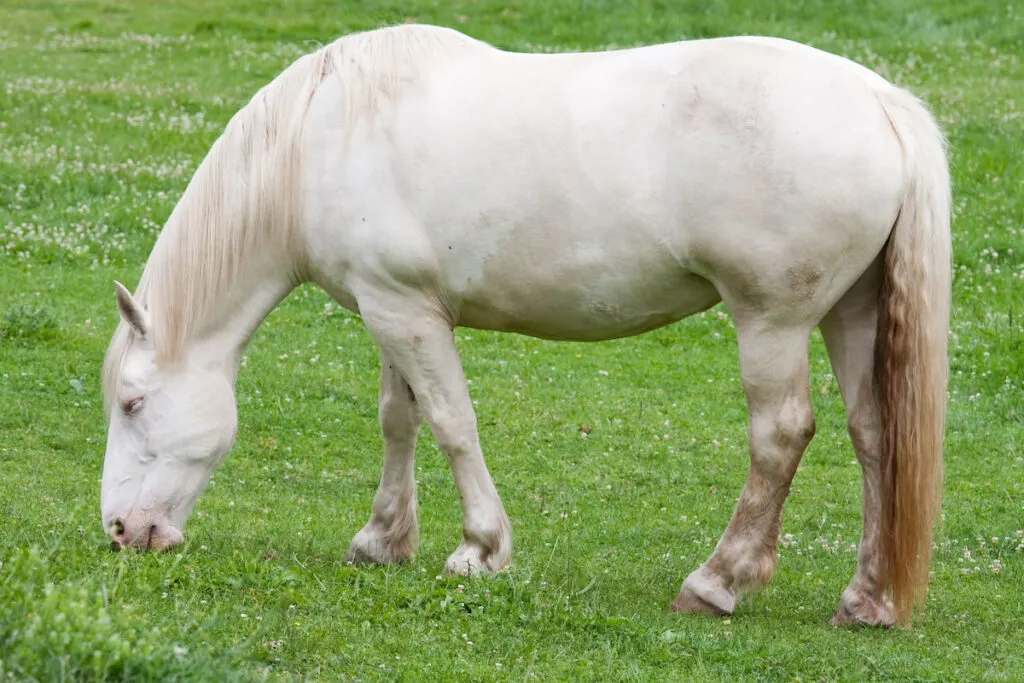
- Height: 18.5-19.5 hands
- Color: Cream, dark brown
- Temperament: Gentle, willing to learn
- Uses: Showing, riding
The American Cream draft is the only draft horse breed from the United States. It’s also one of the easiest to recognize due to its amber eyes and unique cream coat.
Although it was initially developed as a farm animal, increased mechanization led to a drastic decline in the breed.
A mature American Cream draft horse stands between 18-19.5 hands high and weighs about 1,500-2,200 pounds.
These horses are docile and friendly, which makes them suitable for novice horse owners.
American Cream draft horses are willing to learn and are gentle.
American Cream draft horses make excellent farm workers. Their muscular and sturdy bodies can easily pull carriages and other farm tools.
The breed also makes a fantastic riding and show horse as it’s easy to handle.
14. Russian Heavy Draft
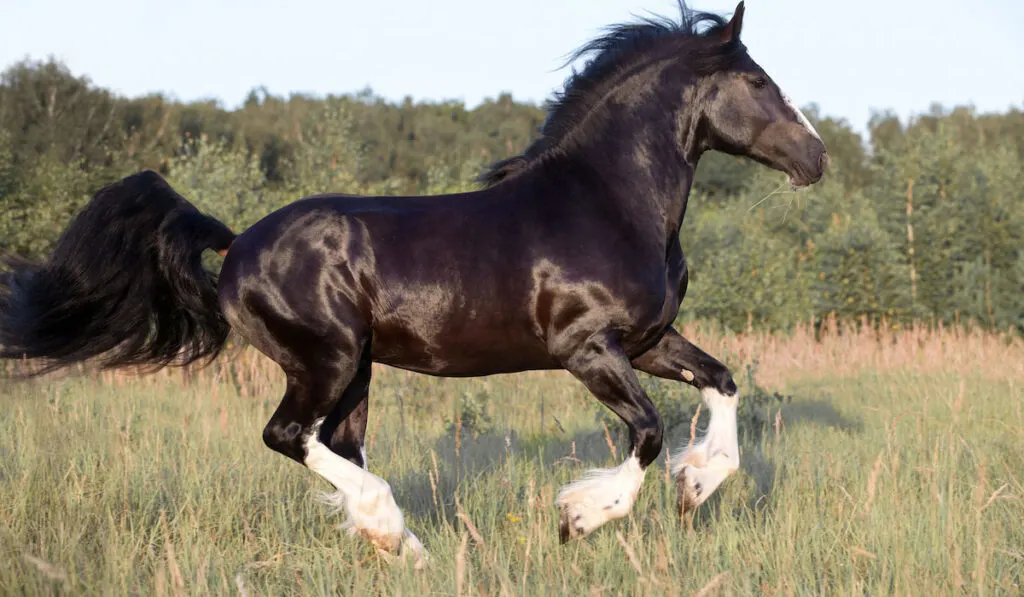
- Height: 14.1-15 hands
- Color: Roan, bay, chestnut
- Temperament: Patient, docile
- Uses: Milk production, farm work
The Russian Heavy draft horse is originally from Russia, developed in the 19th century for farm work and hauling. These horses were bred from different mares like the Brabancon, Percheron, and Orlov Trotter.
A mature Russian Heavy Draft horse stands 14.1-15 hands tall and weighs about 1,400-1,500 pounds. They have a muscular physique despite being small.
Russian Heavy’s have immense strength and energy.
Regarding temperament, Russian Heavy draft horses are patient, docile, and friendly. These horses tolerate cold weather.
Today, people use the Russian Heavy draft for farm work and milk production.
15. Boulonnais
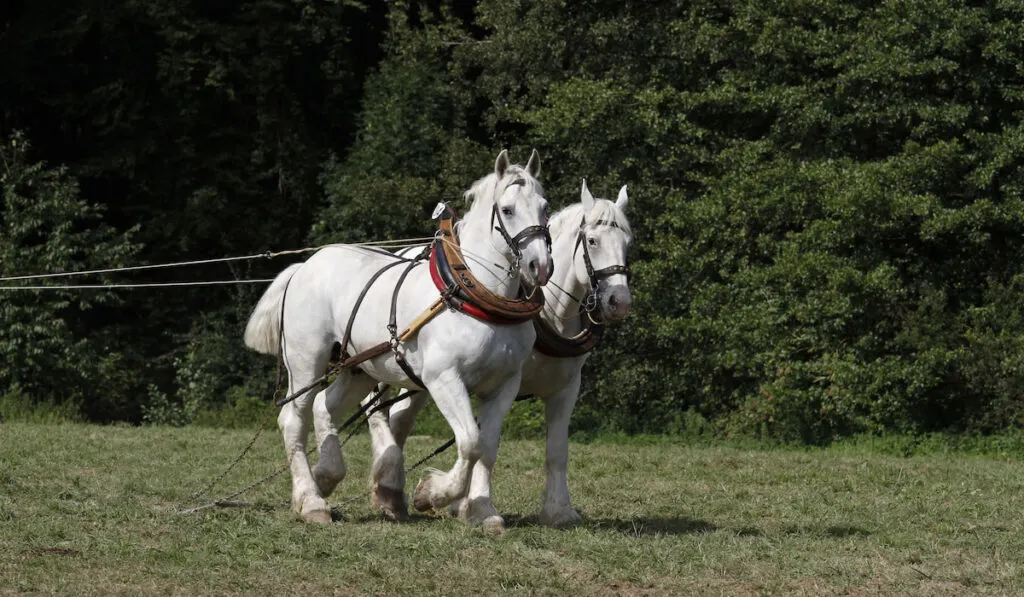
- Height: 14.3-16.3 hands
- Color: Black, gray, chestnut, cream
- Temperament: Gentle, docile, energetic
- Uses: Fieldwork, general riding
Originally from Boulogne, France, the Bouonnais horse may have been imported by Julius Caesar before he invaded Britain.
Their physique is also distinct. A Boulonnais horse has a short head, broad forehead, muscular neck, wide chest, straight back, strong legs, and thick mane.
Boulonnais horses get their majestic demeanor from their unique physique and mane.
Most horses have a creamy coat, but it’s also common to find some breeds with black and chestnut colors.
On average, an adult Boulonnais weighs about 1,400-1,650 pounds and stands 14.3-16.3 hands tall.
They are also sociable horses that are easygoing and friendly despite their size. Horse keepers also find them easily trainable and energetic during physical activities.
Boulonnais horses are now used for general riding and fieldwork. Some people also breed and raise them for meat.
16. Australian Draft Horse
- Height: 16-17.3 hands
- Color: Gray, black, brown, white, roan
- Temperament: Friendly, peaceful
- Uses: Riding horses, show horses, hitch horses
The Australian Draught horse is originally from Australia and was developed in the 1800s as a means of transport.
The Australian Draught horse descends from four purebred draft horses: Shire, Percheron, Clydesdale, and Suffolk Punch.
Crossing four pure draught breeds led to a breed that could survive in extreme conditions, was strong, and had an even temperament. That’s why Australian Draught horses were for draft purposes.
Australian Draught horses can be brown, black, white, roan, and grey. There are several types of Australian Draught horses, but their height is about 16-17.3 hands.
They are famous for their friendly temperaments and calm nature, which makes them easy to train.
Australian Draught horses are now used as riding horses, hitch horses, and show horses.
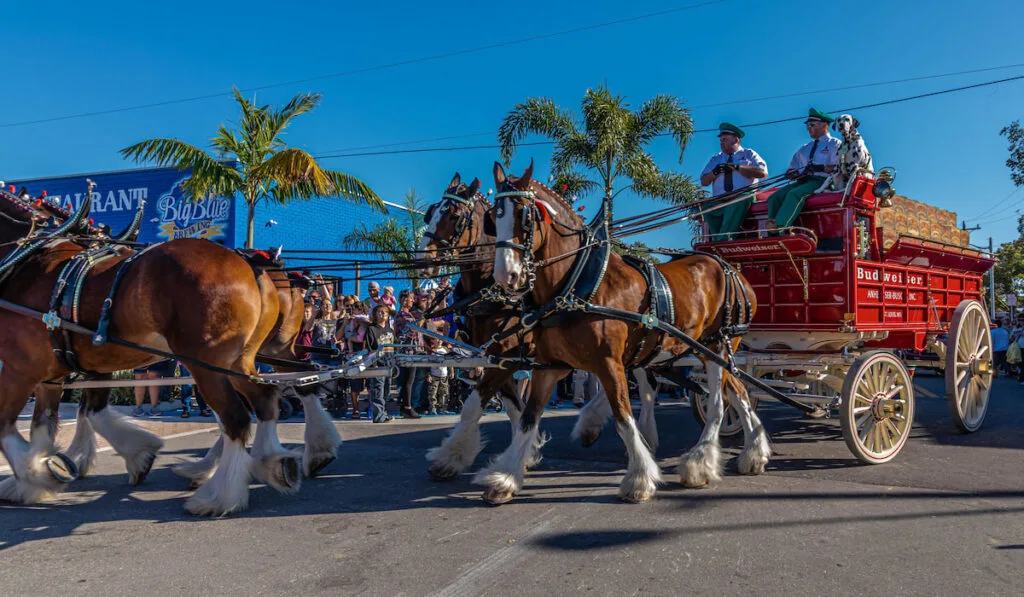
What is the Best Draft Horse to Ride?
The Clydesdale is one of the best draft horses to ride, thanks to their calm and quiet demeanor, but their muscular size and height can be challenging for beginners.
What is the Largest Breed of Draft Horses?
The Shire is the largest breed of draft horses. It’s also one of the largest horses.
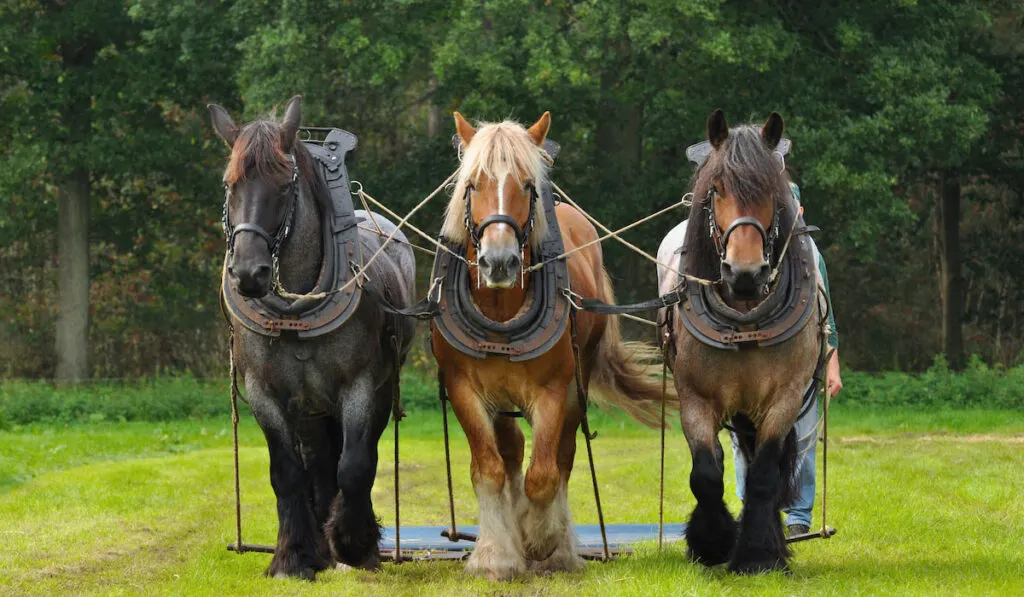
What Kind of Horses Are Draft Horses?
Draft horses are types of horses bred to have the strength to pull heavy loads like hauling hitches when plowing or logging.
Final Thoughts
Draft horses were developed for heavy-duty tasks that required energy and strength, like plowing fields and pulling carriages. However, modern draft horses don’t work as hard.
Nonetheless, they maintain draft horse characteristics like muscular strength, massive bones, and an average height of about 13-19 hands.
Resources
- https://imh.org/exhibits/past/breeds-of-the-world/europe/russian-heavy-draft/
- https://amazinghorsefacts.com/russian-heavy-draft-horse/
- https://petkeen.com/fjord-horse/
- https://horseracingsense.com/draft-horse-breeds-smallest-biggest-gentlest/
- https://horseyhooves.com/draft-work-horse-breeds/
- https://petkeen.com/draft-horse-breeds-for-work/
- https://www.appropedia.org/List_of_draft_horse_breeds
- https://horses.extension.org/draft-horse-breed/
- https://www.equestrianmag.com/draft-horse-breeds/

